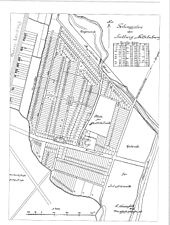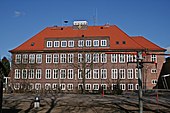Nettelnburg
Nettelnburg ( Low German : Nettelnborg ) is a district of Hamburg-Bergedorf , which borders Allermöhe and Neuallermöhe and lies in the western Elbmarschen. Nettelnburg is not an independent district, but part of the Bergedorf district in the Bergedorf district . Alt-Nettelnburg was built in the 1920s under the direction of the architect Fritz Winterfeldt by a non-profit settler community made up of war participants, war victims and survivors on the area of the former Nettelnburg estate.
From the 1960s, a new building area was built in the west and south-west. After the connection to the sewer system between 1970 and 1980, many parcels in Alt-Nettelnburg were divided to make space for new buildings. On December 31, 2005, the Nettelnburg district had 6,485 inhabitants. Despite the expansion, Nettelnburg's character as a garden city was retained.
history
Documents before 1900
According to a legend handed down by Amalie Schoppe, a branch of the Schauenburg family lived on a "Nettelburg" at the time of the Crusades . In fact, documented evidence that the district Nettelnburg to 1307 to territorially Schauenburger and Stormarn belonged. The field name could be explained by the fact that the Schauenburgers had a nettle or "Nettelblatt" in their coat of arms.
Nettelnburg was first mentioned in a document in 1208 when a Wernherus von Netelenburg appeared as a witness at a property transfer. This at least proves the existence of an early rural fief. According to a sales deed from 1307, the Schauenburgers ceded their “better Nettelenburg” to the “ Reinebeck ” monastery . However, no traces of such a castle have been found.
From 1609 two leasehold farms are occupied, which changed owners and overlords several times. After a major fire in October 1894, a mansion was built as a Wilhelminian style villa from 1895, which the building contractor Philipp Holzmann acquired in 1899. This historic building, which was last used as a restaurant and hotel, was demolished in 2011 despite protests by the Nettelnburg Association.
Expansion of Alt-Nettelnburg
In the first construction phase, a few villas were built around 1900 on Oberen Landweg.
After the First World War , in 1919, due to the housing shortage, members of the social-democratically oriented Reich Association of War Disabled, war veterans and war survivors began to establish a settlement community. The choice fell on the land around the Nettelnburger Gutshof, which had passed into the possession of the industrial terrestrial company Nettelnburg due to the overindebtedness of the previous owners. On March 13, 1921, the newly founded non-profit settlement cooperative Nettelnburg was able to acquire the area despite the high mortgage burden.
The “ Heimatstil ” settlement to the east of the Obere Landweg and west of the Weidenbaumsweg was built between 1921 and 1930 as a planned town under the direction of the Hamburg architect Fritz Winterfeld. First of all, drainage ditches were laid in the heavy marshland before the parceling out of plots larger than 1000 square meters. As a result, the start of construction was delayed until spring 1922.
The brick-built single or semi-detached houses with mansards and half-hip roofs were characteristic . The main entrance was on the ground floor, which is now regarded as the first floor, while the utility and cellar rooms were at ground level due to the high groundwater level and the risk of flooding. Most of the houses had stalls for small livestock. Each settlement house had a large kitchen garden, which was bordered by drainage ditches. By August 1927, 235 houses had already been occupied.
The settlement included shops, a fire station , a school, an inn, a public meeting place with sports facilities and a soccer field, but no church. Most of the settlers were workers or artisans who were close to the SPD.
In the late autumn of 1930 the dike broke, and many of the newly built settlement houses were damaged.
time of the nationalsocialism
Nettelnburg was popularly known as the “Red Settlement”. In the last free Reichstag elections on March 5, 1933 , the SPD received 65.00% of the vote, the KPD received 13.20%, while the NSDAP only received 16.37%. In April 1933, the synchronization began . The community chairman was ousted, his own magazine, the “Nettelnburger Siedler”, was renamed and the editorial team changed. Even the members of the volunteer fire brigade were replaced by party comrades who were loyal to the line, but this did not work out. The headmaster was deposed. From January 1938 a HJ home was built at Oberen Landweg 10 . In the same year Nettelburg was released from membership of Billwerder and incorporated into the Bergedorf district. During the Second World War, Nettelnburg was largely spared from bomb attacks.
New buildings in the post-war period
In the post-war period, following development work, the settlement was expanded by building additional one and two-family houses. The first Nettelnburg apartment building was built in 1954 as a commercial building with 4 shops and 17 apartments above.
Since 1970, single-family houses, some as terraced houses, have been built again in Nettelnburg-Süd, on Oberen Landweg and in Alt-Nettelnburg. These are embedded in a planned landscape of canals and green spaces. Today, Nettelnburg presents itself as a garden city, with the Alt-Nettelnburg settlement being an important architectural monument of the 1920s due to its uniform appearance.
Bugenhagen Church
A characteristic of Alt-Nettelnburg was the fact that a people's house and a sports field, but no church, were planned in the center. It was not until 1929 that a barrack-like makeshift church, the Bugenhagen Hall, was built on the Obere Landweg, outside the settlement . In 1943 the church and pastorate were damaged by bombs. The church hall was then restored and served as a place of worship until the inauguration of the Bugenhagen church on October 26, 1958. On November 5, 1972, a Protestant kindergarten with a playground was opened on the church premises.
Educational institutions
After the settler families moved in in the 1920s, consideration was given to building their own elementary school . After a makeshift school had been set up in the former “mansion”, the “Siedlungsschule” or “School Nettelnburg” on Fiddigshagen was inaugurated on July 28, 1928. The middle wing is stylistically reminiscent of buildings by the Hamburg city architect Fritz Schumacher , although the plans come from the Völker building councilor. Despite the fact that it was a non-denominational community school with co-education , the school was rather social-democratic. 75% of school leavers received the youth consecration . Cultural events for adult education were also offered.
In the time of National Socialism , the headmaster and a teacher were removed. Life science classes were discontinued and religion classes were offered instead. Children from socialist families were defamed.
In the post-war period, following the arrival of other families in 1958, a west wing was added and a gymnasium was built. Since there was still not enough space, pavilions were added later. With the school reform of the eighties, the Nettelnburg school became a pure elementary school , but there are also preschool classes. The school has been an integrative elementary school since 1991 .
sport and freetime
In 1930 the settlers founded a football club, the “1. FC Nettelnburg ". This was banned and dissolved in 1933 because it was a member of the Workers' Gymnastics and Sports Association . In 1946 it was re-established as the “Sport-Club Nettelnburg von 1930 e. V. ". Between 1981 and 1984 the range was expanded to include basketball, volleyball, karate, athletics, swimming, dancing and gymnastics. On November 30, 1995 there was a merger with the TUS Neu-Allermöhe and a renewed renaming to “Sportverein Nettelnburg / Allermöhe von 1930 e. V. "," SVNA 1930 "for short.
politics
For elections to the Hamburg citizenship and the district assembly , Nettelnburg belongs to the constituency of Bergedorf .
Transport links
Since the 1970s, Nettelnburg has owned an S-Bahn station of the same name on the S2 / S21 Hauptbahnhof - Bergedorf - Aumühle line , which also includes the Bergedorf-West development area north of the S-Bahn.
After the construction of the Marschenautobahn A 25 and the development of further new building areas (Neu-Allermöhe East and West), the once rather secluded village character has changed. So livestock farming and vegetable growing were given up. However, with a few exceptions, nothing has changed in the single-family house development.
Water association
On June 15, 1989, the Nettelnburg Water Association was founded with the aim of ensuring the functionality of the ditches in the area of the old settlement for drainage. For this purpose, the owners of the approximately 1000 properties are compulsory members and independently elect a committee, which in turn elects the association's board.
See also
literature
- Culture and History Office (ed.): Nettelnburg, Ritter - Bauern - Siedler , Hamburg 2004, ISBN 3-9806996-8-4 .
- Michael Niemeyer: 800 years - Nettelnburg was first mentioned in a document . In: Lichtwark booklet No. 73. Verlag HB-Werbung, Hamburg-Bergedorf, 2008. ISSN 1862-3549 .
- Willy Uske: Nettelnburg through the ages . In: Lichtwark No. 51. Ed. Lichtwark Committee, Bergedorf, 1987. See now: Verlag HB-Werbung, Hamburg-Bergedorf. ISSN 1862-3549 .
- Culture and History Office (ed.): 850 years of Bergedorf. A city story . Hamburg 2012, ISBN 978-3-942998-02-4 , pp. 98-108.
Web links
- Historical photos of Nettelnburg (private site)
- Holmer Stahncke: tracked down. Nettelnburg: On the outskirts of Bergedorf . Article in the Hamburger Abendblatt from June 2, 2007
Individual evidence
- ↑ Culture and History Office (ed.): 850 years of Bergedorf. A city story . Hamburg 2012, ISBN 978-3-942998-02-4 , p. 108
- ↑ Culture and History Office (ed.): 850 years of Bergedorf. A city story . Hamburg 2012, ISBN 978-3-942998-02-4 , pp. 98-99
- ↑ Culture and History Office (ed.): 850 years of Bergedorf. A city story . Hamburg 2012, ISBN 978-3-942998-02-4 , p. 105
- ↑ Culture and History Office (ed.): 850 years of Bergedorf. A city story . Hamburg 2012, ISBN 978-3-942998-02-4 , p. 100
- ↑ Culture and History Office (ed.): 850 years of Bergedorf. A City History. Hamburg 2012, ISBN 978-3-942998-02-4 , p. 102
Coordinates: 53 ° 28 ′ 39.2 " N , 10 ° 11 ′ 34.5" E



